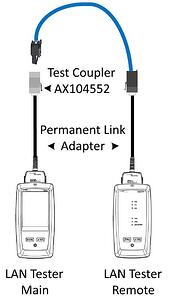En préparation : normes pour le test des fiches et prises
La question de savoir si un câble de catégorie peut fournir la bande passante et la capacité dont vous avez besoin se résume aux performances installées : le câble tient-il ses promesses une fois qu'il est installé ?
Si les câbles sont endommagés pendant le tirage, si la connectivité n'est pas correctement terminée, si les câbles sont fabriqués de manière incorrecte ou si l'environnement n'est pas propice aux performances réseau souhaitées, le câble peut ne pas fonctionner comme prévu. C'est pourquoi il est essentiel de s'assurer que le câblage et les composants répondent à certains paramètres une fois l'installation terminée.
Le test des câbles permet de vérifier que le travail d'installation a été effectué conformément aux normes requises, qu'aucun dommage n'est survenu et que toutes les connexions sont correctement terminées pour fournir les performances attendues. Si des problèmes sont détectés, ils peuvent être corrigés rapidement afin d'éviter des interruptions de service imprévues et des frustrations.
ANSI/TIA-568C.2 is the current standard that cable should be tested to - it describes all elements of a structured cabling infrastructure, including requirements for cables, permanent links, connectors, hardware and patch cords. ANSI/TIA-568C.2 is currently being modified to include all current addendums, including Category 8 cable. The next version, which will be released in late 2018, will be called ANSI/TIA-568.2-D.
The updated version will also include a normative Annex F – Modular Plug Terminated Link, which performance can be measured and compared to for modular plug terminated links (MPTLs) – also known as Direct Connect. This connection method simplifies LAN infrastructure by allowing plugs to be placed at the ends of horizontal cabling and run straight to IP devices.
MPTLs are tested as jack to plug, and meet all requirements of a permanent link. Proper testing requires a permanent link adapter and patch cord test head. Below are methods for testing MPTLs and permanent link configurations. Each is accompanied by a figure that represents the testing topology.
Jack-to-Jack Tests
Exigences:
- Main and remote field testers
- Permanent link adapters (x2)
- Actual permanent link being tested

There are four steps to follow during jack-to-jack tests:
- Install the tester and remote unit on both sides of the permanent link
- Select the cable type to be tested
- Select the “permanent link” limit with the appropriate category and standards
- Test all permanent links
Plug-to-Jack Tests
Exigences:
- Main and remote field testers
- Permanent link adapter
- Patch cord test head
- Actual permanent link being tested
There are four steps to follow during plug-to-jack tests:
- Install the tester and remote unit on both sides of the permanent link
- Select the cable type to be tested
- Select the “MPTL” limit with the appropriate category and standards
- Test all permanent links

Plug-to-Jack Tests (Belden Alternative)
<pRequirements:- Main and remote field testers
- Permanent link adapters (x2)
- Belden coupler test adapter AX104552
- Actual permanent link being tested
There are four steps to follow during plug-to-jack tests:
- Install the tester and remote unit on both sides of the permanent link
- Select the cable type to be tested
- Select the “permanent link” limit with the appropriate category and standards
- Test all permanent links

REVConnect Testing
The Belden REVConnect Connectivity System is a form of Direct Connect, which allows contractors to terminate a jack or plug onto the same universal core interface; its universal wiring manager supports Category 5e, 6 and 6A cables. It allows field-terminable plugs used to support Category 6A and PoE applications to be terminated just as easily as a jack.
With REVConnect, a single termination process works for every application. You can switch from a jack to a plug or vice versa without having to re-terminate. Learn more here.
